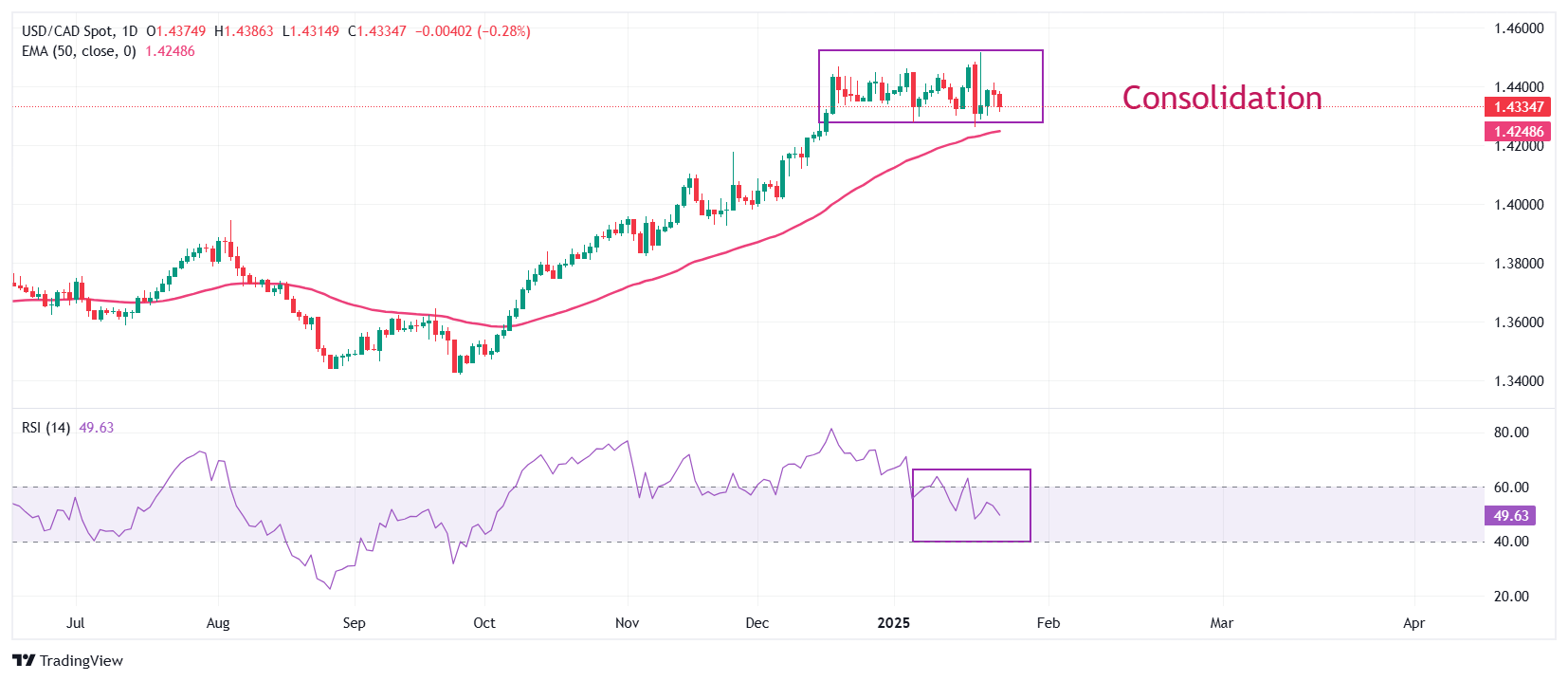USD/CAD Price Forecast: Declines to near 1.4320 as Trump endorses immediate rate cuts
- USD/CAD slumps to near 1.4320 as the US Dollar faces selling pressure.
- US Trump’s call for instant rate cuts has dampened the US Dollar’s appeal.
- The BoC is widely anticipated to cut interest rates by 25 bps to 3% next week.
The USD/CAD pair falls sharply to near 1.4320 in Friday’s North American session. The Loonie pair faces a sharp sell-off as the US Dollar (USD) tumbles after United States (US) President Donald Trump calls for the need for immediate interest rate cuts in his speech at the World Economic Forum (WEF) at Davos.
The impact is clearly visible on the US Dollar Index (DXY), which has posted a fresh monthly low near 107.45.
Trump’s call for swift policy-easing has come just a few days before the Federal Reserve’s (Fed) first monetary policy on January 28-29, in which the central bank is certain to keep interest rates unchanged in the range of 4.25%-4.50%.
While investors have underpinned the Canadian Dollar (CAD) against the US Dollar (USD) in the short term, its outlook remains weak as Donald Trump is poised to raise tariffs by 25% on Canada and Mexico on February 1. Trump showed concerns over the 4% trade deficit with Canada while speaking at WEF.
Higher tariffs on Canada would boost expectations of further policy-easing by the Bank of Canada (BoC), which is widely anticipated to cut interest rates by 25 basis points (bps) to 3% on Wednesday.
USD/CAD trades in a tight range of 1.4260-1.4465 for over a month. The outlook of the Loonie pair remains firm as the 50-day Exponential Moving Average (EMA) slopes higher, which trades around 1.4248.
The 14-day Relative Strength Index (RSI) falls into the 40.00-60.00 range, suggesting a sideways trend.
The rally in the Loonie pair could advance to near the round-level resistance of 1.4600 and March 2020 high of 1.4668 if the asset breaks above the January 21 high of 1.4518.
On the contrary, a downside move below the December 11 low of 1.4120 could drag the asset towards the December 4 high of around 1.4080, followed by the psychological support of 1.4000.
USD/CAD daily chart

Canadian Dollar FAQs
The key factors driving the Canadian Dollar (CAD) are the level of interest rates set by the Bank of Canada (BoC), the price of Oil, Canada’s largest export, the health of its economy, inflation and the Trade Balance, which is the difference between the value of Canada’s exports versus its imports. Other factors include market sentiment – whether investors are taking on more risky assets (risk-on) or seeking safe-havens (risk-off) – with risk-on being CAD-positive. As its largest trading partner, the health of the US economy is also a key factor influencing the Canadian Dollar.
The Bank of Canada (BoC) has a significant influence on the Canadian Dollar by setting the level of interest rates that banks can lend to one another. This influences the level of interest rates for everyone. The main goal of the BoC is to maintain inflation at 1-3% by adjusting interest rates up or down. Relatively higher interest rates tend to be positive for the CAD. The Bank of Canada can also use quantitative easing and tightening to influence credit conditions, with the former CAD-negative and the latter CAD-positive.
The price of Oil is a key factor impacting the value of the Canadian Dollar. Petroleum is Canada’s biggest export, so Oil price tends to have an immediate impact on the CAD value. Generally, if Oil price rises CAD also goes up, as aggregate demand for the currency increases. The opposite is the case if the price of Oil falls. Higher Oil prices also tend to result in a greater likelihood of a positive Trade Balance, which is also supportive of the CAD.
While inflation had always traditionally been thought of as a negative factor for a currency since it lowers the value of money, the opposite has actually been the case in modern times with the relaxation of cross-border capital controls. Higher inflation tends to lead central banks to put up interest rates which attracts more capital inflows from global investors seeking a lucrative place to keep their money. This increases demand for the local currency, which in Canada’s case is the Canadian Dollar.
Macroeconomic data releases gauge the health of the economy and can have an impact on the Canadian Dollar. Indicators such as GDP, Manufacturing and Services PMIs, employment, and consumer sentiment surveys can all influence the direction of the CAD. A strong economy is good for the Canadian Dollar. Not only does it attract more foreign investment but it may encourage the Bank of Canada to put up interest rates, leading to a stronger currency. If economic data is weak, however, the CAD is likely to fall.

